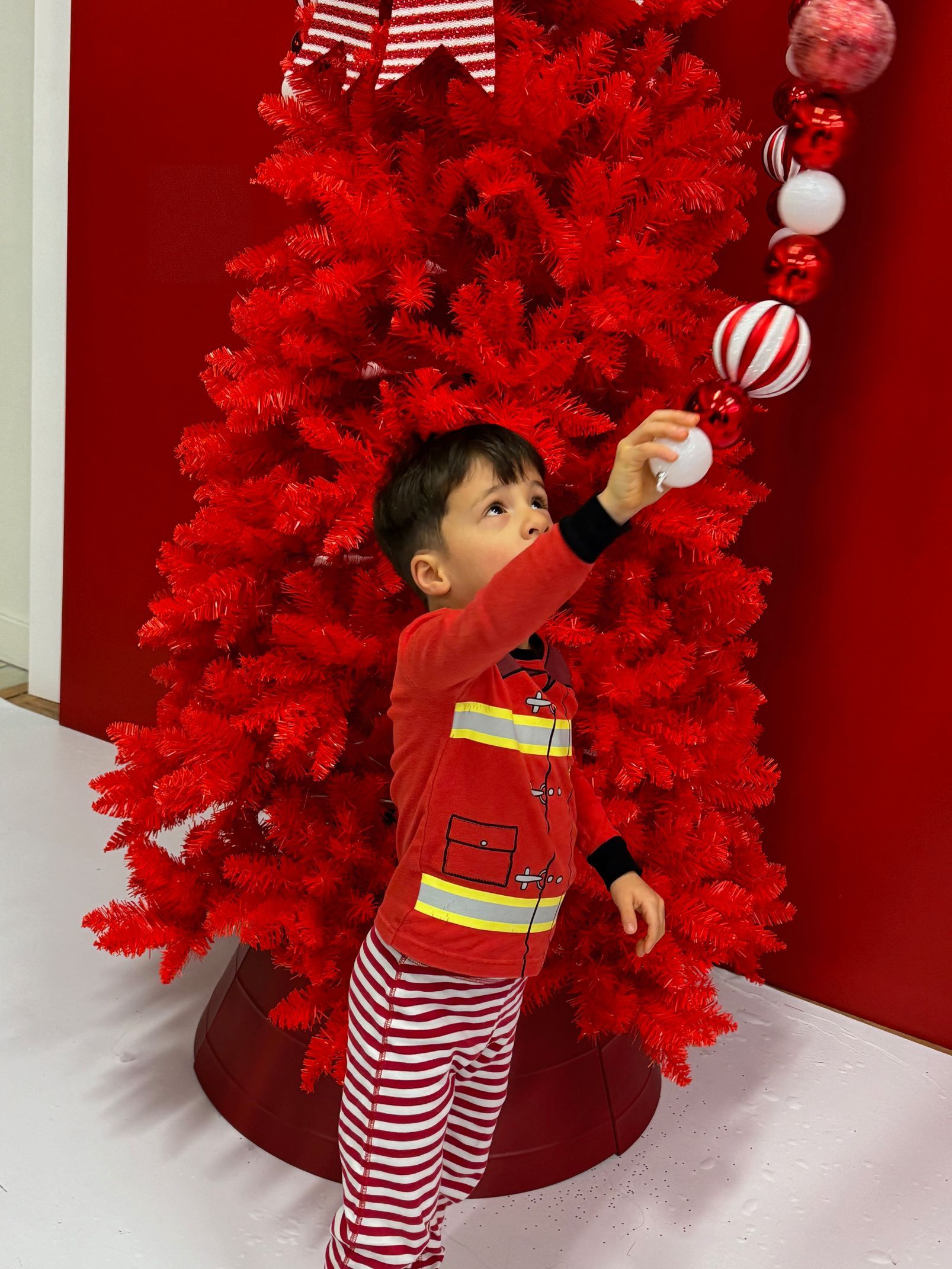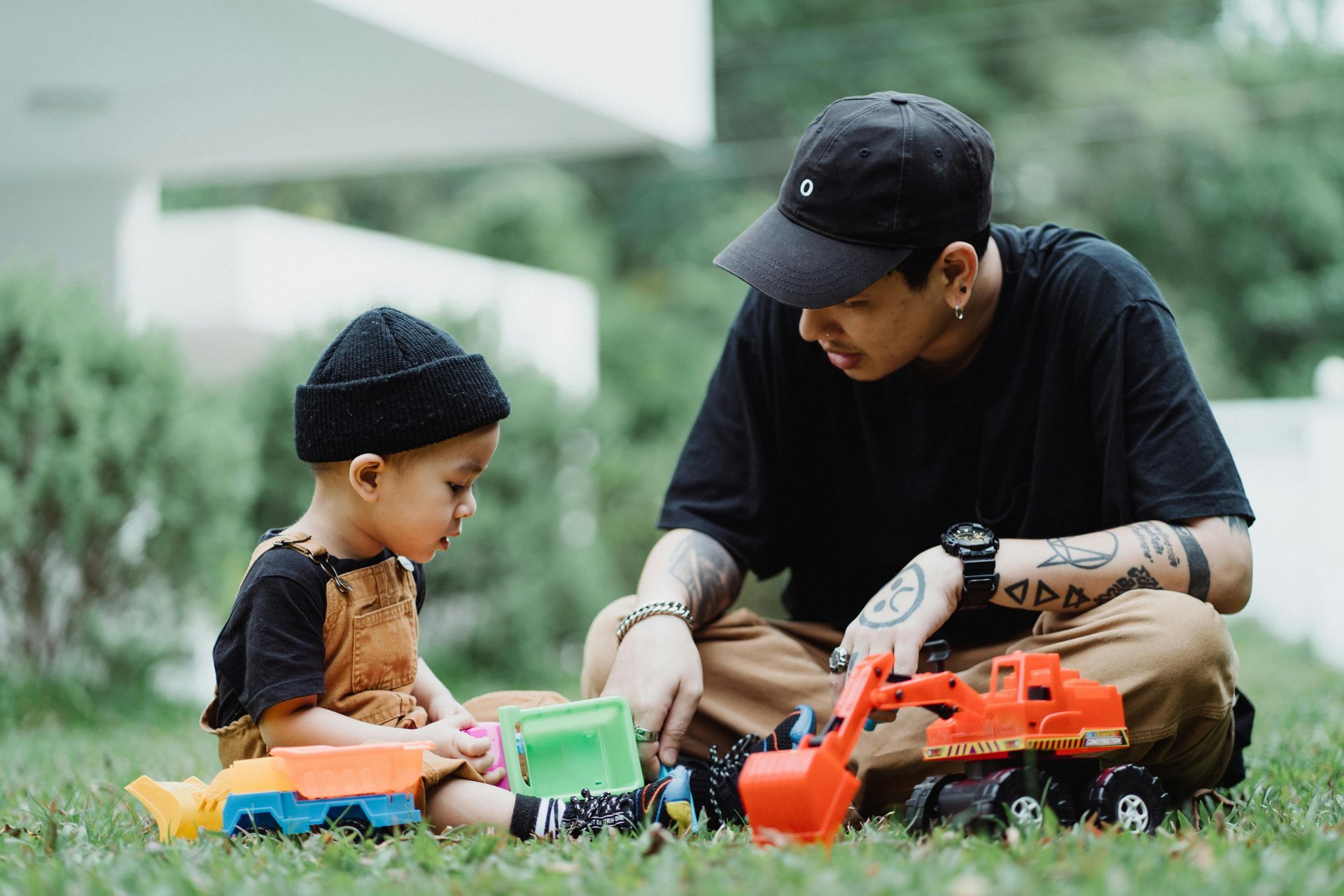Healing Your Inner Child
Catherine Kelly • December 21, 2024
While Guiding Your Own: A Transformational Journey
Parenting is often described as the most rewarding yet challenging journey one can undertake. It pushes us to confront our past while shaping the future of our children. When you embody the example you wished you had as a child, you not only equip your children with valuable coping strategies but also begin the profound process of healing your inner child.
Here are actionable tips to foster this transformative connection:
1. Encourage Emotional Expression
Give your children the space and vocabulary to express their feelings. Validate their emotions by saying things like, “I see you’re upset, and that’s okay.” When you allow this openness, you’re not only helping them process emotions but also sending a message to your inner child: “It’s safe to feel.”
2. Apologize When You’re Wrong
Admitting your mistakes models humility and accountability. Saying, “I’m sorry for yelling earlier; I was frustrated, but it wasn’t your fault,” shows your child that making amends is part of growth. For your inner child, this is a reminder that no one is perfect and mistakes don’t diminish love or worth.
3. Be Open About Your Emotions
Sharing age-appropriate insights into your feelings normalizes vulnerability. Saying, “I’m feeling overwhelmed today, so I’m taking deep breaths to calm down,” teaches emotional regulation. For your inner child, this breaks the cycle of emotional suppression and fosters self-acceptance.
4. Spend Quality Time Doing What They Love
Dedicate uninterrupted time to activities your children enjoy, whether it’s building blocks, painting, or playing make-believe. This shows them that their interests matter. Simultaneously, you affirm to your inner child that joy and connection are priorities.
5. Teach Healthy Coping Strategies
Model simple techniques like deep breathing, counting to ten, or taking a break when emotions run high. For example, say, “Let’s take a few deep breaths together before we decide what to do next.” These tools not only serve your children but also equip your inner child with healthier responses to stress.
6. Have Honest Conversations
Don’t shy away from discussing tough topics. Answer questions with honesty and compassion, showing that you’re a safe space for curiosity and concerns. As you engage in these moments, you’re rewriting the narrative for your inner child, proving that hard conversations can lead to growth, not fear.
7. Allow Them to Correct You
Give your children permission to speak up when they feel misunderstood. Saying, “Thank you for telling me how you feel; I’ll try to do better,” nurtures mutual respect. This does not mean encouraging disrespect but rather teaching them how to respectfully disagree and voice their feelings in a constructive way. This act also affirms to your inner child that their voice matters.
8. Model the Behavior You Wish to Instill
Children learn best by example. Demonstrate kindness, patience, and resilience in everyday life. When they see you practicing what you preach, it reinforces their understanding and builds their confidence in navigating challenges. For your inner child, this consistent modeling reinforces a sense of stability and self-worth.
The Ripple Effect of Healing
By actively practicing these steps, you’re doing more than parenting—you’re healing. Each intentional act of love and patience not only shapes your children’s emotional well-being but also rewrites your inner child’s story. The coping strategies you teach your children become the tools your inner child finally receives, creating a ripple effect of healing and empowerment.
Final Thoughts
Parenting is an invitation to grow alongside your children. As you become the example you wished you had, you’re not only nurturing your children’s potential but also reclaiming and rewriting your own. This dual journey of parenting and self-healing creates a legacy of resilience, empathy, and connection that transcends generations.
Be the parent your child needs and the one your inner child deserves. The transformation is worth every step.
If this resonates with you, I invite you to take the first step on your own journey. Learn more about the transformational path that empowered me to become the parent I aspired to be — a journey rooted in healing, growth, and a deeper connection with my children and myself. Click below to discover how you can begin today.

When I first became a parent, I thought I was doing everything right. I had read the books, followed the blogs, and believed I could avoid the parenting missteps I had experienced growing up. But I quickly learned that the path to empowered parenting isn't paved with perfection—it's paved with awareness, healing, and intention. I grew up in a household shaped by perfectionism. My father insisted on straight lines, perfect circles, and learning cursive by age five. Messes were unacceptable, and mistakes often led to shame. My mother, while trying not to repeat her own upbringing, often echoed the message, "If you're going to do something, do it right the first time." Though she meant well, those words planted deep seeds of pressure and performance in me. That perfectionism followed me into parenting. I saw it when my son spilled juice, and I snapped—not because of the spill itself, but because it triggered an old wound. I was reliving the very fear-based parenting I had vowed to avoid. That moment became my wake-up call. The turning point came When I stopped asking, "Why is my child acting this way?" and started asking, "Why am I reacting this way?" That shift didn’t just change my parenting—it saved my marriage. I had been viewing my relationship through a lens of blame: "What’s wrong with you?" But when I began to explore what was being triggered in me, I found clarity, compassion, and connection. Everything changed When I discovered Jai Institute for Parent Coaching. It gave me the tools to understand that all behavior—mine and my children’s—is communication. I learned to regulate my nervous system, breathe before I react, and show up with calm leadership instead of control. I let go of the myth of perfection and embraced progress instead. One of the most powerful moments Came during a swimming lesson with my twins. We had been alternating turns for safety, but one day, my oldest twin forgot it wasn’t his turn. He had a full meltdown—yelling, kicking, flailing. People stared. My old self would’ve tried to stop the scene for the sake of appearances. But I chose differently. I held him. I validated his disappointment. I didn’t correct or shame him—I co-regulated with him. Later that night, he came down with a fever. He hadn’t just been upset—he was on the verge of getting sick. That moment reminded me: when we hold space for our children, we teach them that emotions are safe. Conscious parenting is not about perfection. It’s about presence. It’s about breaking generational cycles and leading our families with values, intention, and compassion. My sons teach me every day—one through his emotional sensitivity, the other through his bold challenges. And I now have the tools to show up for both. This journey began with Jai Parent Coaching. It taught me to see behavior as communication, to lead with empathy, and to prioritize connection over correction. It helped me become not only a better parent—but a better partner, a better listener, and a more grounded human being. If you’re feeling overwhelmed, reactive, or stuck in old patterns, I want you to know you’re not alone. You have the power to shift. You can break the cycle. You can breathe easier. 👉 Ready to explore how conscious parenting can transform your family? Visit www.breatheeasyparenting.com and schedule a free strategy call. Let’s start your journey toward intentional, empowered parenting—together.

Parenting isn’t just about managing behavior—it’s about energy, presence, and connection. Inspired by the wisdom of Cesar Millan, this blog explores the power of calm, assertive parenting and how our energy directly shapes our children's behavior. Guilt Doesn’t Show Love Let’s start with a truth many of us don’t talk about: guilt doesn’t make you a better parent. In fact, it often does the opposite. Guilt weighs you down, clouds your judgment, and keeps you stuck in self-doubt. Cesar Millan once said, “Guilt doesn’t really help anything. It doesn’t show love.” As parents, we often feel guilty when our child misbehaves, throws a tantrum, or struggles emotionally. But parenting from guilt causes us to overcompensate or disconnect instead of leaning in with love and leadership. The real gift we can offer is not guilt-driven parenting—but empowered action rooted in emotional connection. The Power of Calm, Assertive Leadership Cesar Millan’s philosophy of calm, assertive energy isn’t just about dogs—it applies beautifully to parenting. Children, like animals, pick up on our emotional energy before we even say a word. When we parent from a place of calm, confidence, and clear boundaries, we create emotional safety. Our children trust us more, feel more secure, and are better able to regulate their emotions. I saw this in action long before I became a parent—when I was just 15 years old walking dogs as a job. One day, I was walking a beautiful blonde Springer Spaniel. I was calm, focused, and took that job seriously. We were at the park when I paused to rest on a rock. Suddenly, another dog of the same breed—but with a black coat—charged toward us aggressively. Without panicking, I stood up, took a deep breath, and stepped between the dogs. I raised my voice firmly but not frantically—“No!” I extended my arm to create space and protect the dog I was walking. Even though I got injured in the process, I never lost that sense of calm assertiveness. I remember the shock of the other dog's owner simply calling his dog and leaving without checking on me. But the moment stayed with me because it taught me something powerful: assertiveness doesn’t mean aggression—it means confidence, clarity, and control in moments of stress. That experience shaped how I show up now, not just with dogs or children, but in life. Natural Consequences—The Best Teachers One of my favorite tools in parenting is allowing natural consequences to do the teaching. For example, if a child refuses to wear their coat on a chilly morning, they’ll feel cold. That simple, non-punitive consequence teaches more than a lecture ever could. No shame, no yelling—just a natural cause-and-effect lesson. This principle came alive for me when my sons were climbing trees at the park. My rule is simple: if you climb up, you must climb down. I won’t rescue you. One twin climbed confidently and got down easily. The other got stuck high in the branches—and I couldn’t help even if I wanted to. I stayed calm and said, “You climbed up, now figure out how to come down. Trace your steps, one branch at a time.” He did it—and when he finally reached the ground, he ran to me with a huge hug and said he’d think twice next time. That was a moment of growth, courage, and natural consequence all rolled into one. Boundaries Built on Trust and Respect Calm, assertive parenting isn’t about control—it’s about clarity and connection. At home, we keep it simple. Our two main house rules are: Keep your feet on the floor (to prevent dangerous climbing accidents). Respect personal space (especially when someone says “STOP”). When one of my boys crosses a boundary, we redirect—not with shame, but with structure. We have a cozy space we call “the EGG,” where they can take a break and reset. It’s not a punishment. It’s a space for reflection and personal regulation. Sometimes they go on their own; sometimes I gently suggest it. Either way, it’s part of helping them tune into their own needs and learn self-regulation. Your Energy Shapes Your Child’s Behavior Research in attachment theory and emotional regulation shows that children mirror our emotional states. If we’re overwhelmed or anxious, our children often act out more. But when we stay grounded, confident, and emotionally available, we help their nervous systems settle and regulate. Just like animals respond to calm leadership, our children thrive under calm, assertive parenting. Your breath, your tone, your posture—it all communicates safety. So if your child is struggling, start by checking your own energy. Are you holding stress in your body? Are you breathing deeply? Are you leading with calm or reacting from fear? Final Takeaway Parenting isn’t about perfection—it’s about progress, presence, and connection. Calm assertive parenting helps your children feel safe, seen, and supported. Whether you’re setting boundaries, navigating meltdowns, or walking through big emotions, your energy is your most powerful parenting tool. So take a breath, trust yourself, and remember: connection over correction. ✨ Want more support on this journey? Visit www.breatheeasyparenting.com or follow me on Instagram @breatheeasyparenting. Let’s grow together—one calm breath at a time.

Parenting is a rewarding yet demanding journey, often filled with busy schedules, endless tasks, and unexpected challenges. Amid the daily responsibilities, we sometimes overlook one of our most valuable resources—play. Play isn’t merely entertainment; it's a powerful way to strengthen your relationship with your children, foster emotional growth, and bring joy back into daily routines. My Personal "Play" Awakening There was a day when my patience felt stretched thin. My twin boys were restless, tired, and irritable, and I wasn't far behind. Feeling overwhelmed, I almost gave in to frustration. Instead, in a moment of clarity, I suggested we play a quick, silly game. Within moments, stress and tension transformed into laughter and connection. This simple shift reminded me of how essential play is—not only for our children but also for us as parents. Why Play Is Essential Play is a universal language for children. It's how they communicate, process emotions, learn new skills, and explore the world around them. When we actively participate in play, we enter our child's world, sending a powerful message: "I see you, I value your ideas, and you matter to me." Research consistently backs this up—children who engage in regular playful interactions with caregivers show enhanced emotional intelligence, stronger social skills, and better stress management. More than anything, play is the foundation for a trusting, secure parent-child relationship. Practical Tips to Easily Add Play to Your Day You don't need special toys or complicated setups to engage in meaningful play. Here are simple, actionable ways you can add playfulness to your everyday parenting: Let Your Child Lead: Even 10 minutes of letting your child choose the activity makes them feel respected and heard. Be Playfully Spontaneous: Turn mundane moments into opportunities for fun—like an impromptu dance party or silly face contests. Transform Daily Routines: Incorporate play into routine tasks. Use fun storytelling during mealtimes, or turn clean-up into a playful competition. Make it a Ritual: Establish a special weekly play tradition, such as family game night, that your children can look forward to regularly. Overcoming Playtime Barriers Many parents express that they're too tired, stressed, or unsure about how to play. Here’s a gentle reminder: Keep it Simple: Short, intentional play moments can have significant impacts. Aim for Authenticity, Not Perfection: Children crave genuine engagement, not elaborate setups. Embrace the Joy: Playfulness benefits adults, too, providing relaxation and stress relief. Final Thoughts By integrating simple, playful moments into your daily routine, you not only build stronger emotional bonds with your children but also cultivate a more joyful, resilient family atmosphere. Remember, parenting isn’t about perfection—it's about progress, connection, and embracing the beautiful simplicity of play. Reflection Questions for You: What's your favorite playful memory with your child? How can you bring more playfulness into your daily interactions? What playful ritual can you introduce this week? I’d love to hear from you! Share your playful experiences with me on Instagram @breatheeasyparenting or visit breatheeasyparenting.com for more resources and inspiration.

Parenting is one of the most profound and fulfilling experiences in life, yet it can also feel overwhelming, exhausting, and at times, joyless. If you've ever found yourself longing to reconnect with the deep love you have for your child but feeling stuck in the daily grind, you're not alone. Falling in love with parenting again isn’t about adding more to your plate—it’s about shifting your perspective and making space for connection, presence, and joy. Here are five simple yet transformative ways to help you rediscover the love and fulfillment in your parenting journey. 1. Slow Down & Just Observe One of the most powerful ways to reconnect with the joy of parenting is to simply watch your child . No instructions, no distractions—just observing. I remember one evening when I sat quietly in the playroom, just watching my boys without intervening. One was lining up toy cars in a perfect row, while the other was carefully setting up a stuffed animal tea party. I noticed how one furrowed his brow in deep concentration, just like I do when I’m focused. The other had his father’s expressive hands, using big gestures as he animatedly talked to his stuffed animals. It struck me in that moment—how often do we actually see our children for who they are, beyond our expectations and to-do lists? Just watching them reminded me of the magic of their individuality and why I fell in love with being their mother in the first place. Try it: The next time you feel disconnected, take five minutes to simply observe your child. Notice their expressions, their quirks, the way they interact with the world. You might just fall in love with them all over again. 2. Create a Small Daily Ritual of Connection Connection happens in the small, everyday moments , not just during vacations or big family events. One of the best ways to rekindle your love for parenting is to create a simple daily ritual with your child. For us, bedtime stories became more than just a routine—it became our moment of joy. I started using silly voices, pausing for dramatic effect, and letting my boys pick their favorite books. One night, I encouraged them to make up their own voices for the characters, and their giggles filled the room. That small shift turned bedtime into one of the most cherished parts of our day . Try it: Find a tiny moment each day —whether it’s a morning cuddle, a dance party before dinner, or a special way of saying goodnight—that brings joy and connection to both you and your child. 3. Shift from Correction to Curiosity Parenting can feel like a constant cycle of correcting and redirecting. But what if, instead of always correcting behavior, we approached our children with curiosity ? Just last week, one of my sons had a full-blown meltdown at swim class because he thought it was his turn to swim when, in reality, it was his brother’s. His frustration escalated into yelling and kicking, and I could feel the weight of other parents' eyes on me, silently expecting me to “handle” the situation. In the past, I might have reacted with frustration, rushing to quiet him down. But instead, I chose to pause and validate his emotions. “You’re really upset because you thought it was your turn, huh? That’s so disappointing.” I let him feel, rather than forcing him to suppress his emotions. Later that night, he came down with a fever—his meltdown wasn’t just about missing swim class. His body was telling him something, and he needed my support, not my correction. Try it: The next time your child has a big emotion, instead of jumping to correction, ask yourself: What is my child trying to communicate? This small shift can turn frustration into connection . 4. Laugh Together Every Day Laughter is one of the easiest ways to reignite joy in parenting . Sometimes, the best way to reconnect isn’t through deep conversations or serious teaching moments—it’s through pure, playful fun . One evening, after a particularly long day, I decided to put on music while we cleaned up the living room. What started as a simple clean-up routine turned into a spontaneous dance party . My boys were giggling as they showed off their “best” moves, and before I knew it, we were all laughing until we collapsed on the couch. That moment reminded me— joy is found in the ordinary . Try it: Have a laugh goal each day. Tell a silly joke, make funny faces, start a tickle war, or have a ridiculous dance-off in the kitchen. Playfulness brings back the lightness in parenting. 5. Give Yourself Grace & Take Breaks You can’t fall in love with parenting if you’re running on empty . If you’re feeling exhausted and disconnected, you need space to recharge . I remember a morning during the newborn phase with my twins. I had been up all night, pumping, breastfeeding, barely getting moments of rest. That morning, I tried to make coffee for my husband—but I didn’t even drink coffee. I put in way too much water, made a huge mess, and just stood there crying in exhaustion . My husband walked in, saw what happened, and instead of making me feel guilty, he gently led me to the couch, took over, and let me rest. That moment taught me: I don’t have to do everything. I need rest too. Try it: Give yourself permission to take breaks without guilt . Set your child up with crayons and coloring books while you breathe for ten minutes. If you need to, let them watch a short show while you sip tea and reset. A well-rested parent is a more present parent. Final Thoughts: Love is in the Little Things Falling in love with parenting again isn’t about big changes —it’s about the small, intentional shifts in how we see and interact with our children. It’s about: Slowing down and noticing the beauty in the everyday moments Bringing playfulness and joy into routine tasks Allowing ourselves to rest and recharge so we can show up with more patience and love If parenting has felt like a never-ending cycle of exhaustion, take a step back. Observe. Appreciate. Laugh. Hold your child a little longer. The love is still there—you just have to give yourself the space to feel it again. And if you’re struggling with feeling connected in parenting, my Breathe Easy Parenting Program is here to help. Let’s work together to create more peace, confidence, and connection in your parenting journey. 👉 Click here to sign up for a free discovery call and take the first step toward falling in love with parenting again. Until then, breathe easy—you’ve got this.

As a parent, you’ve probably heard about how artificial intelligence (AI) can make life easier. From baby monitors that track vital signs to apps that help children learn at their own pace, AI promises convenience, peace of mind, and support in the daily chaos of parenting. But as I’ve discovered firsthand, relying on AI too much can sometimes lead us away from what matters most—our connection with our children. How AI Fits into Modern Parenting AI tools have made parenting more manageable in many ways: Monitoring and Safety: Devices like the Owlet Smart Sock track your baby’s vital signs and alert you to irregularities. Learning Support: Apps like Khan Academy Kids tailor educational content to your child’s unique learning style. Creative Play: Smart toys such as Miko 3 and Moxie engage kids in storytelling, emotional learning, and fun activities. These tools are undeniably helpful, especially for parents of multiples or those juggling hectic schedules. But as I’ve learned, there’s a fine line between using AI as a tool and letting it overshadow the natural, instinctive ways we connect with our children. A Personal Experience with AI and Parenting Recently, I turned to AI during a particularly difficult time with my twins. They were constantly fighting, and despite using every strategy I knew—validating their feelings, encouraging cooperative play, and giving them space—I felt stuck. Frustrated, I grabbed my phone and asked AI for advice. As I scrolled through suggestions, which mirrored much of what I was already doing, my twins’ cries filled the room. One of them tugged at my leg, needing comfort. I realized I was so focused on finding a “better” solution that I was ignoring what my instincts told me to do: pick them up and hold them. So I put down my phone, gathered both of them into my arms, and sat with them. In that moment, I realized that no AI suggestion could replace the power of simply being present. It wasn’t about finding the “perfect” fix; it was about showing them love and reassurance in the moment they needed it most. The Hidden Risks of Relying on AI My experience highlights some of the potential downsides of over-relying on AI in parenting: Eroding Instincts: The ease of getting advice from AI can make us doubt our own instincts as parents. Overloading with Information: Too many suggestions can lead to guilt, shame, and the sense that you’re never doing enough. Losing Connection: Time spent searching for solutions can take us away from being fully present with our children. How to Use AI Mindfully AI can be a helpful tool, but it’s important to use it in ways that support—rather than replace—your natural parenting instincts. Here’s how: Trust Your Gut: AI can offer ideas, but your instincts are often the best guide for your child’s needs. Limit AI Use: Turn to AI for support with logistics or ideas, not as a replacement for emotional connection. Focus on Presence: Prioritize spending time with your children without distractions, especially during emotionally charged moments. Teach Your Kids About AI: As they grow, help them understand the limits of AI and the importance of human connection. A Question for Reflection As you navigate parenting in a tech-driven world, ask yourself: Is AI helping me connect with my children, or is it creating distance? AI has its place, but it’s our love, presence, and humanity that leave the deepest mark on our children. By staying mindful, we can use technology to enhance parenting without letting it take over. Ready to Parent with Confidence? Parenting isn’t easy, but you don’t have to navigate it alone. At Breathe Easy Parenting, I help parents like you rediscover their instincts, build meaningful connections with their children, and create a calmer, more joyful home life—even in the chaos of raising twins or multiples. If you’re feeling overwhelmed by the challenges of parenting or unsure how to balance modern tools with timeless connection, let’s work together. My Breathe Easy Parenting Program is designed to give you the tools, support, and encouragement you need to become the parent you’ve always wanted to be. 💬 Let’s connect! Sign up today for a Free Strategy Call below. Your Parenting Journey Matters Parenting isn’t about perfection—it’s about being present. If you’re ready to take a deep breath, lean into connection, and parent with purpose, I’m here to help.

As parents, individuals, and humans in progress, it’s easy to fall into the trap of self-blame and regret. You may find yourself replaying past mistakes, wondering if you’ll ever truly move on. But here’s the truth: mistakes are part of growth, not the end of the story. Forgiveness isn’t about erasing the past—it’s about offering yourself compassion and a second chance to learn and grow. In this guide, you’ll discover practical steps, actionable tips, and mindfulness practices to help you release self-blame and embrace the power of healing. 1. Rewriting Your Narrative Your past experiences and mistakes are chapters in your story—not the entire book. Rewriting your narrative starts with seeing those chapters as opportunities for growth, not proof of failure. Affirmation: “My past is part of me, but it doesn’t define me. I choose to write my story with compassion and hope.” Practical Tip: • Reflective Journaling: Write about a time when you felt stuck in guilt or regret. Then rewrite the story, focusing on the lessons you learned and the strengths you gained. • Visualization Exercise: Picture your story as a blank canvas. Imagine painting a vibrant, hopeful image of your future. What colors and shapes represent your growth? Breathing Practice: Before journaling or visualizing, take five deep breaths. Inhale possibility; exhale judgment. Let each breath anchor you in your power to transform your narrative. 2. Embracing Self-Forgiveness Forgiving yourself is a gift you give to your soul. It’s not about forgetting—it’s about releasing the emotional weight of guilt and shame to make room for healing. Affirmation: “I forgive myself for not knowing then what I know now. I am learning, growing, and moving forward.” Practical Tip: • Self-Compassion Practice: Stand in front of a mirror and speak to yourself as you would a friend. Say something like: “I see your pain, and I honor your effort to grow. You are doing your best, and that is enough.” • Small Acts of Forgiveness: Each day, identify one small thing you’re ready to forgive yourself for. Write it down and say, “I release this.” Breathing Practice: Breathe in for four seconds, focusing on self-compassion. Hold for three seconds, allowing forgiveness to take root. Exhale for six seconds, letting go of guilt. Repeat five times. 3. Releasing Regret Over the Past Regret is a natural response to missed opportunities, but it becomes harmful when it turns into shame. Releasing regret means reframing mistakes as moments of learning. Affirmation: “I release the past with love and focus on the growth it has given me.” Practical Tip: • Mindfulness Check-In: When you catch yourself saying things like, “I always mess up,” pause. Reframe the thought to: “I made a mistake, and that’s okay. I’m learning.” • Release Ritual: Write down one regret on a piece of paper. Safely tear or burn it, symbolizing your choice to let it go. Breathing Practice: Take a deep breath and imagine each inhale bringing light into your body. With each exhale, visualize releasing the knots of regret. Repeat until you feel a sense of lightness. 4. Nurturing Self-Acceptance Self-acceptance is about embracing every part of yourself—the strong and the vulnerable. It’s a journey of progress, not perfection. Affirmation: “My imperfections are part of my beauty. I accept myself fully, just as I am.” Practical Tip: • Daily Reflection: At the end of each day, write down three things you did well—even small moments like making time for yourself or listening deeply to someone. • Self-Talk Practice: When self-doubt creeps in, pause and say: “I am enough, and I am worthy of love and compassion.” Breathing Practice: Breathe deeply and place your hand over your heart. With each inhale, imagine filling your body with love. With each exhale, release any judgment. Repeat until you feel calm. 5. Four Steps to Forgive Yourself Self-forgiveness is a process of courage and intention. These steps will guide you through it: Step 1: Take Responsibility • Recognize your role in a situation without harsh judgment. Say: “I take responsibility for my actions, and I am committed to growth.” Step 2: Feel and Express Remorse • Write a letter to yourself or someone you’ve hurt. You don’t need to send it—it’s about processing and releasing the emotions. Step 3: Make Amends • Think of one tangible way to rebuild trust, whether with yourself or others. This could be setting a boundary, practicing self-care, or apologizing sincerely. Step 4: Be Patient • Remind yourself: healing is a journey, not a sprint. Celebrate small victories along the way. Breathing Practice: After each step, pause and take a cleansing breath. Inhale strength; exhale fear. Repeat until you feel grounded. 6. The Power of Breathing Breathing is one of the simplest yet most powerful tools for healing. It brings you into the present moment and helps you release tension. Affirmation: “With each breath, I create space for peace and healing in my life.” Breathing Practice: • The 4-7-8 Technique: o Inhale for four seconds. o Hold for seven seconds. o Exhale for eight seconds. Repeat three times, noticing how your body begins to relax. Daily Tip: Set aside two minutes in the morning or evening for mindful breathing. Let it be your anchor, a moment to reconnect with yourself. Your Journey Forward: Every breath, every moment of reflection, and every small step you take is progress. You are not defined by your past—you are shaped by your growth and resilience. Remember: you are the author of your story, and every day is a chance to write a new chapter. If you’re ready to dive deeper into this work, I invite you to explore how personalized guidance can help you move forward. Visit Breathe Easy Parenting to learn more about my coaching services and resources designed to empower you on your journey. Together, we can transform self-blame into self-compassion, one step—and one breath—at a time.






